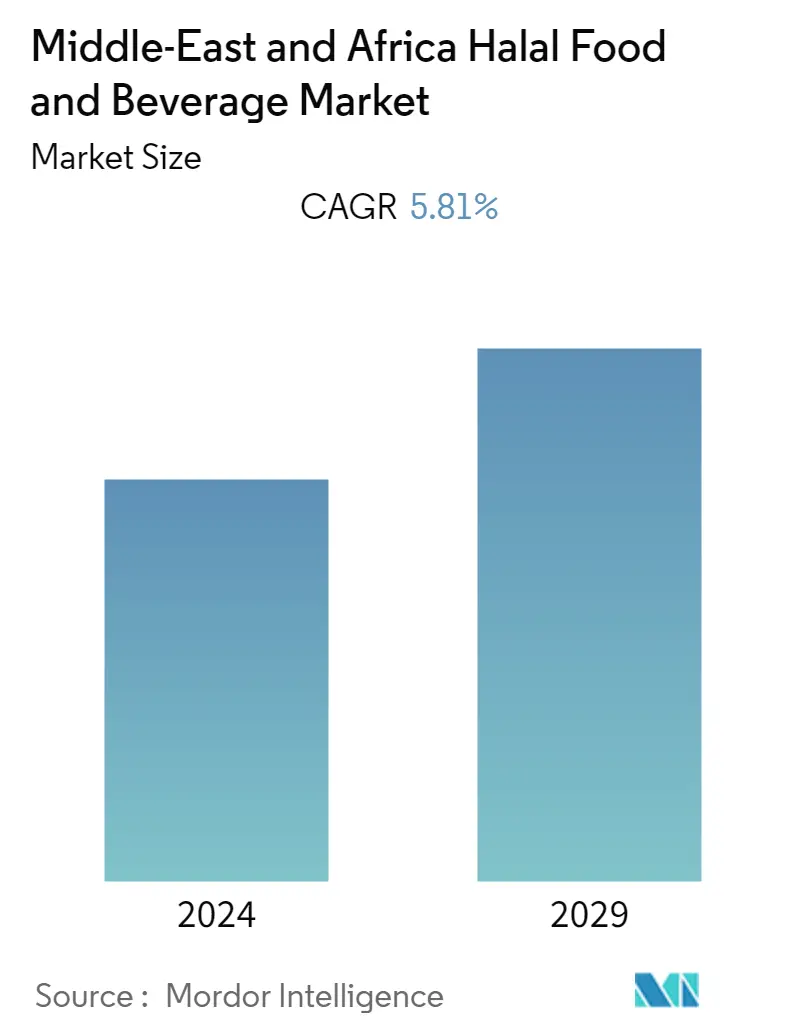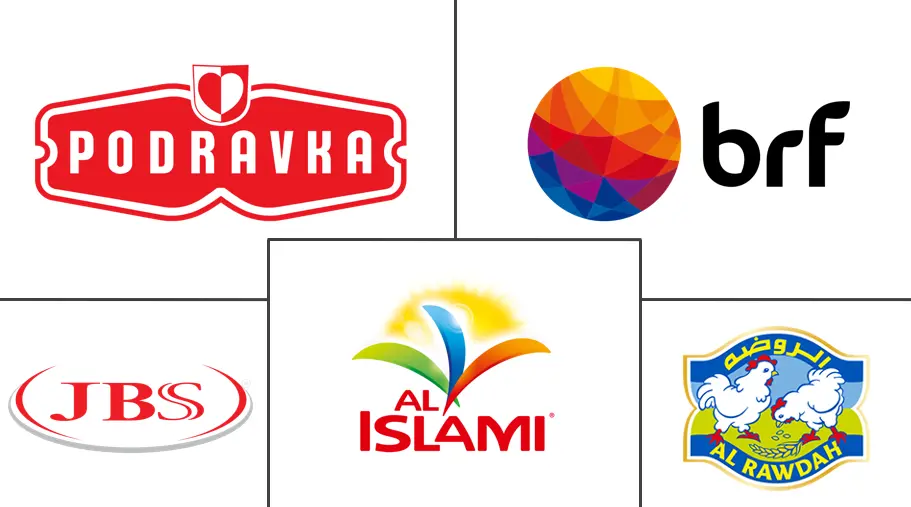Market Size of Middle-East and Africa Halal Food and Beverage Industry

| Study Period | 2019 - 2029 |
| Base Year For Estimation | 2023 |
| Forecast Data Period | 2024 - 2029 |
| Historical Data Period | 2019 - 2022 |
| CAGR | 5.81 % |
| Market Concentration | Low |
Major Players
*Disclaimer: Major Players sorted in no particular order |
MEA Halal Food & Beverage Market Analysis
The Middle-East and Africa halal food and beverage market is projected to witness a CAGR of 5.81%, during the forecast period (2021-2026).
The unprecedented outbreak of the COVID-19 pandemic has not only been a tragic health issue globally but has severely impacted the global economy on account of restrictions set by the government. However, despite its massive impact on the industries worldwide, the challenges posed to the Halal food industry in the middle-east and Africa region have not been significant enough, owing to the ever-increasing demand for halal food & beverage products majorly across countries like Saudi Arabia, United Arab Emirates, Kuwait, Egypt, and Bahrain, among others. Also, Ramadan was a period amidst the pandemic, which accelerated the sales of halal products in the region. Additionally, consumers shifted to home cooking, and online shopping for their daily essentials. The Saudi supermarket BinDaWood Holding reported their e-commerce sales increased by 200%, according to the World Halal Authority. With manufacturing, production, and logistical operations being disrupted, key exporters have had a challenging year financially, but, an increase in e-commerce, increased the demand for food security initiatives, and more clear labelling of healthier foods including halal products in the region.
Over the medium term, the growing awareness of halal food and its positioning as hygienic and healthy food among, both, Muslim and non-Muslim communities, has resulted in an increase in the consumption and acceptance of halal food, which is expected to drive the demand over the forecast period. Furthermore, the assurance of integrity throughout the Halal supply chain has become a major concern for Muslim consumers, with fraudulent Halal certification and physical contamination of food products on the rise. Hence, supply chain integrity needs to be protected right from the point of animal slaughter and including transportation, storage, to the handling of Halal products.
MEA Halal Food & Beverage Industry Segmentation
Halal is an Arabic word that means 'permissible'. The Middle-East and Africa market for halal food and beverages is segmented by product type that includes halal food, halal beverages, and halal supplements. The halal food section is further divided into meat, processed meat, and other products. Based on the distribution channel, the market is segmented into hypermarkets/supermarkets, specialty stores, convenience stores, online retail stores, and other distribution channels. The study also involves the analysis of regions, such as Saudi Arabia, United Arab Emirates, South Africa, and the Rest of the Middle-East and Africa. For each segment, the market sizing and forecasts have been done on the basis of value (in USD million).
| By Type | |||||
| |||||
| Halal Beverage | |||||
| Halal Supplements |
| By Distribution Channel | |
| Hypermarkets/Supermarkets | |
| Specialty Stores | |
| Convenience Stores | |
| Online Retail Stores | |
| Other Distribution Channels |
| By Geography | |
| Saudi Arabia | |
| United Arab Emirates | |
| South Africa | |
| Rest of Middle-East and Africa |
Middle-East and Africa Halal Food and Beverage Market Size Summary
The Middle-East and Africa halal food and beverage market is experiencing significant growth, driven by increasing demand across countries such as Saudi Arabia, the United Arab Emirates, Kuwait, Egypt, and Bahrain. Despite the challenges posed by the COVID-19 pandemic, the market has shown resilience, with a surge in e-commerce and home cooking contributing to the demand for halal products. The market is characterized by a growing awareness of halal food as hygienic and healthy, appealing to both Muslim and non-Muslim consumers. This awareness, coupled with concerns over supply chain integrity and fraudulent certification, is expected to drive further demand. The market's expansion is also supported by the rising Muslim population and disposable income, making halal food and beverages a lucrative segment for investment.
Saudi Arabia is poised to be the fastest-growing country in the region's halal food and beverage market, supported by government policies aimed at increasing domestic production and reducing reliance on imports. The market is highly competitive, with numerous regional and multinational players such as Al Islami Foods, Podravka Gulf FZE, and JBS SA vying for market share. Companies are focusing on optimizing production processes and leveraging advanced technology to ensure compliance with halal standards. Innovations such as plant-based halal-certified products and antibiotic-free chicken lines are indicative of the market's dynamic nature. The ongoing expansion efforts by companies like Tanmiah Food Company highlight the region's potential for growth, both locally and internationally.
Middle-East and Africa Halal Food and Beverage Market Size - Table of Contents
-
1. MARKET DYNAMICS
-
1.1 Market Drivers
-
1.2 Market Restraints
-
1.3 Porter's Five Forces Analysis
-
1.3.1 Threat of New Entrants
-
1.3.2 Bargaining Power of Buyers/Consumers
-
1.3.3 Bargaining Power of Suppliers
-
1.3.4 Threat of Substitute Products
-
1.3.5 Intensity of Competitive Rivalry
-
-
-
2. MARKET SEGMENTATION
-
2.1 By Type
-
2.1.1 Halal Food
-
2.1.1.1 Halal Meat
-
2.1.1.2 Processed Meat
-
2.1.1.3 Other Products
-
-
2.1.2 Halal Beverage
-
2.1.3 Halal Supplements
-
-
2.2 By Distribution Channel
-
2.2.1 Hypermarkets/Supermarkets
-
2.2.2 Specialty Stores
-
2.2.3 Convenience Stores
-
2.2.4 Online Retail Stores
-
2.2.5 Other Distribution Channels
-
-
2.3 By Geography
-
2.3.1 Saudi Arabia
-
2.3.2 United Arab Emirates
-
2.3.3 South Africa
-
2.3.4 Rest of Middle-East and Africa
-
-
Middle-East and Africa Halal Food and Beverage Market Size FAQs
What is the current Middle-East and Africa Halal Food and Beverage Market size?
The Middle-East and Africa Halal Food and Beverage Market is projected to register a CAGR of 5.81% during the forecast period (2024-2029)
Who are the key players in Middle-East and Africa Halal Food and Beverage Market?
Al Islami Foods, Podravka Gulf FZE, JBS S.A., BRF SA and Al Rawdah Foods are the major companies operating in the Middle-East and Africa Halal Food and Beverage Market.

